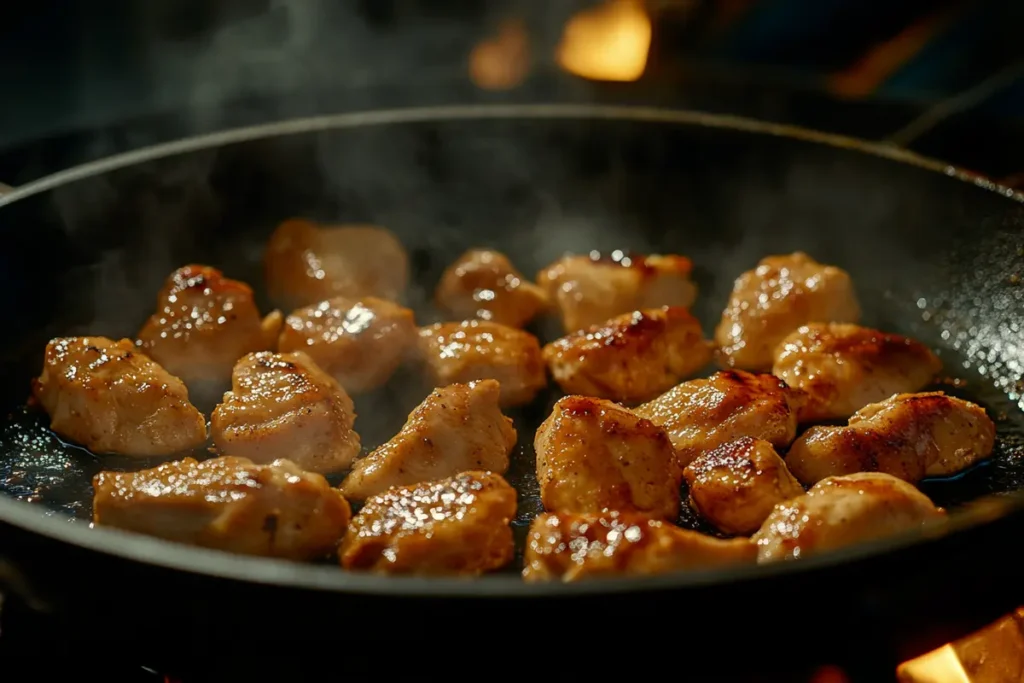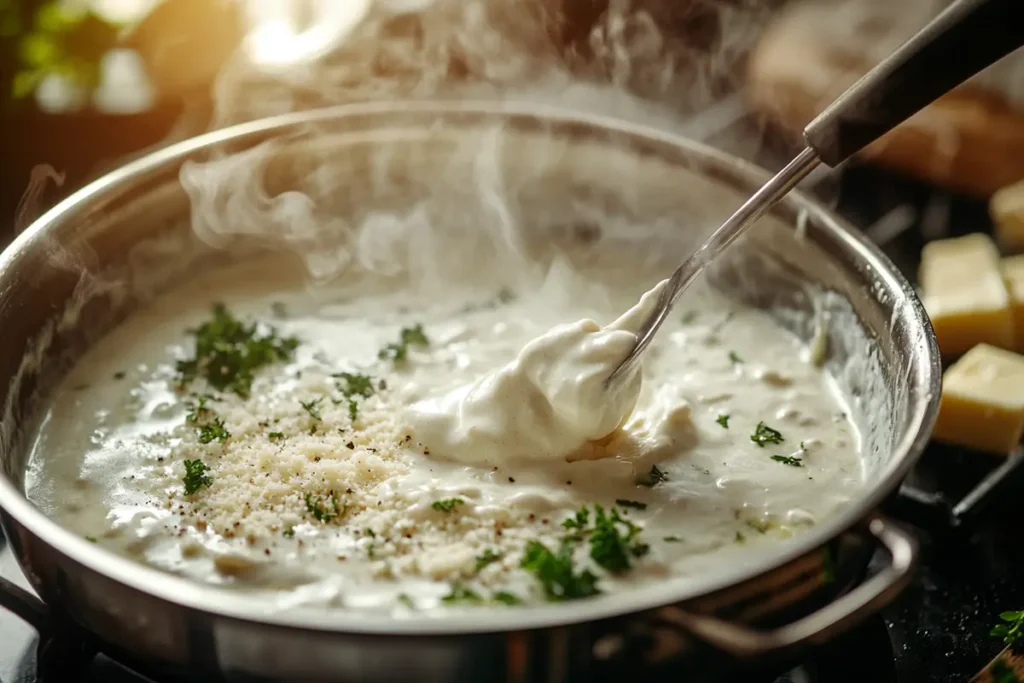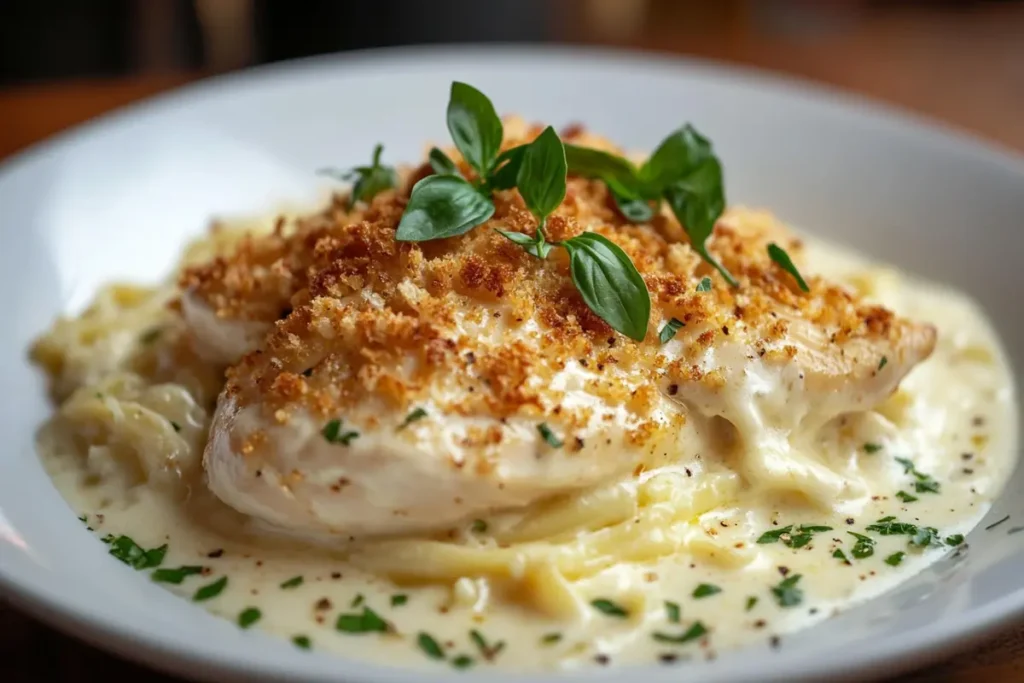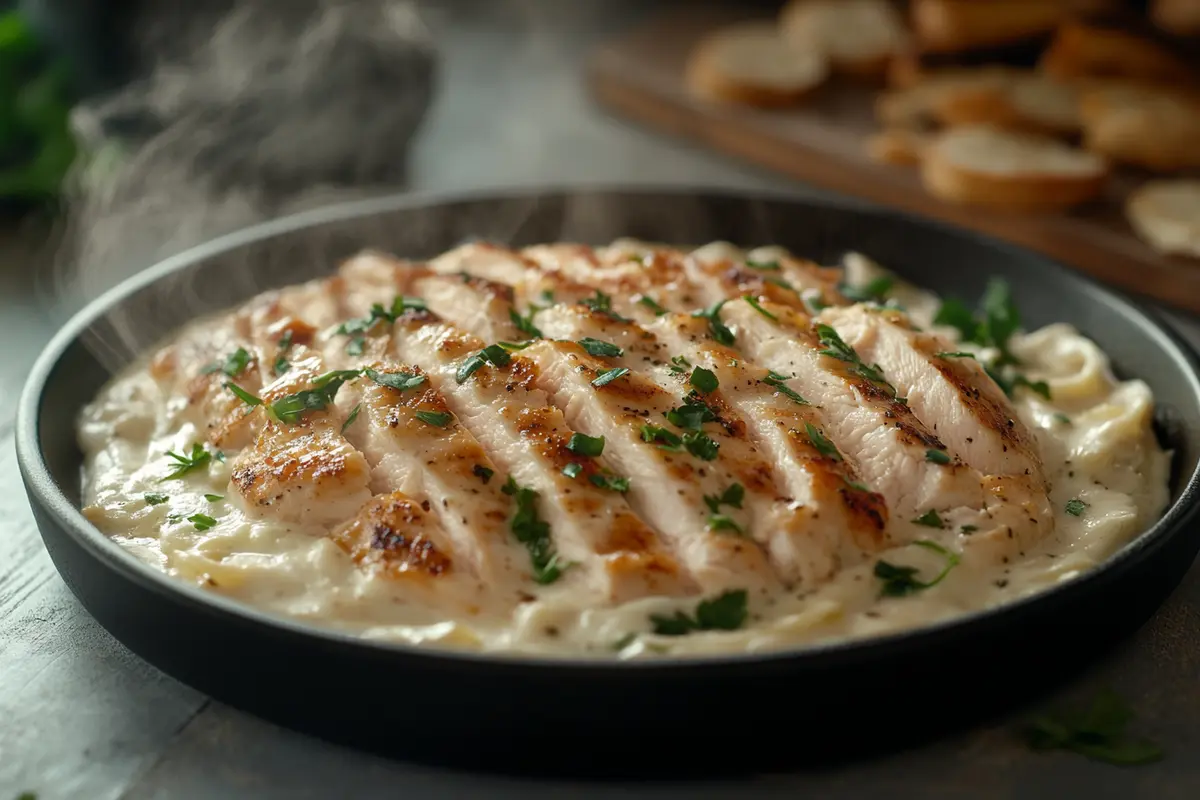How can I make my chicken alfredo taste better? This question arises when your dish lacks depth. Chicken Alfredo should taste rich, creamy, and unforgettable. Yet, many find their version ordinary, bland, or missing a special spark.
Introduction: Rediscovering Chicken Alfredo
When you think of chicken Alfredo, you imagine tender chicken, creamy sauce, and perfectly cooked pasta. However, reality sometimes disappoints. A dull sauce, chewy chicken, or bland seasonings leave you craving more flavor. Therefore, to fix this issue, focus on simple steps that add dimension to every bite.
You can uplift your dish by improving ingredient quality, cooking techniques, and seasoning profiles. In addition, consider how texture, aroma, and presentation affect taste. By applying these strategies, you will never ask how can I make my chicken alfredo taste better? again.
Start with High-Quality Ingredients
Quality starts at the grocery store. For chicken, choose fresh, never-frozen cuts. Preferably, select boneless, skinless chicken breasts or thighs. They cook quickly and remain tender. Always look for reputable brands known for freshness.
For pasta, buy a premium brand. A good fettuccine holds sauce better and delivers a pleasant bite. In addition, pick high-quality Parmesan cheese. Authentic Parmigiano-Reggiano melts smoothly and enhances creaminess. Also, use real butter and fresh garlic cloves. Avoid jarred garlic since it often tastes weak. Therefore, every component matters.
Focus on Proper Seasoning
Proper seasoning solves the common problem of bland flavor. Salt your pasta water to boost the noodle’s subtle taste. Season chicken well with salt and pepper before cooking. In addition, consider using a pinch of red pepper flakes or smoked paprika for depth. Light spices elevate chicken without overpowering it.
Moreover, use fresh cracked black pepper instead of pre-ground powder. Fresh pepper grains impart a brighter, bolder kick. Therefore, each element of the dish contributes to a final, balanced flavor profile.
Marinate the Chicken for Depth
Marinating chicken adds layers of flavor. Even a short marinade improves taste. For example, whisk together olive oil, minced garlic, lemon juice, salt, and herbs. Let the chicken rest in this mixture for at least 30 minutes.
This simple step infuses meat with subtle tang and aroma. In addition, marinade tenderizes the chicken slightly, ensuring juicy texture. Therefore, when you finally cook the chicken, it stands out with more complexity.
Use Proper Cooking Techniques
Sometimes chicken Alfredo fails due to poor cooking methods. Overcooked chicken turns dry and rubbery. Undercooked pasta tastes stiff. In addition, scorching the garlic creates bitterness. To avoid these pitfalls, follow best practices:
- Cook Pasta Al Dente: Boil until tender but firm. Overcooked pasta turns mushy.
- Sauté Chicken Over Medium Heat: Start with a hot pan, then lower heat to prevent dryness.
- Add Garlic at the Right Time: Introduce garlic after the chicken browns. Cook it gently to avoid burning.
By refining technique, you prevent errors that dull flavors. Therefore, your dish emerges balanced and delicious.

Embrace Fresh Herbs and Aromatics
When pondering how can I make my chicken alfredo taste better? think about fresh herbs. A sprinkle of chopped parsley or basil adds brightness. Moreover, fresh thyme or oregano elevates savory notes. Aromatics like shallots or fresh green onions also contribute complexity.
For example, sauté some shallots before adding cream. Their gentle sweetness rounds out the sauce. Use herbs sparingly to maintain balance. Therefore, fresh greens and aromatics highlight flavors rather than overshadow them.
Enhance the Sauce with Quality Dairy
Alfredo sauce revolves around butter, cream, and cheese. Therefore, using top-notch dairy matters. Buy real cream, not half-and-half. Full-fat cream provides luxurious body and richness. In addition, choose high-quality butter. European-style butter often contains more butterfat, enhancing mouthfeel.
Grate Parmesan cheese by hand. Pre-shredded cheese includes anti-caking agents that affect melting. Freshly grated Parmesan melts into a silky sauce. Hence, the sauce clings to every strand of pasta.

Add a Splash of Pasta Water
Reserved pasta water, rich in starch, helps thicken and smooth your sauce. Before draining pasta, scoop out half a cup of its cooking water. After mixing cream and cheese, stir in some pasta water.
This step ensures a creamy consistency that never feels clumpy. In addition, pasta water helps bind sauce to noodles. Consequently, every bite tastes cohesive and balanced.
Finish with a Hint of Acidity
A hint of acidity prevents your Alfredo from tasting too heavy. For example, a squeeze of lemon juice brightens the dish. Lemon’s fresh tang contrasts with the rich cream and cheese.
However, use acidity sparingly. One teaspoon of lemon juice can suffice. Taste and adjust as needed. Therefore, you create a lively, well-rounded flavor profile.
Experiment with Additional Cheeses
While Parmesan is classic, consider blending in small amounts of other cheeses. Gruyère adds nuttiness, while pecorino romano brings bold, salty intensity. Fontina or mascarpone can enhance creaminess.
Add these cheeses gradually, tasting as you go. Too much may overpower the dish. However, when balanced well, cheese combinations answer the question how can I make my chicken alfredo taste better? with rich results.
Include Vegetables for Texture and Flavor
Adding vegetables improves taste and variety. For example, toss in sautéed mushrooms, roasted cherry tomatoes, or steamed broccoli. Vegetables offer color, sweetness, and freshness.
In addition, artichokes or spinach contribute earthy notes. Their presence contrasts with creamy sauce and savory chicken. Therefore, a balanced blend of ingredients keeps your Alfredo interesting.
Season in Layers
Seasoning isn’t a single step. Instead, add small amounts of salt, pepper, and herbs throughout cooking. Taste after each addition. Adjust gradually.
By seasoning in layers, you maintain control. You prevent oversalting, which ruins delicate flavors. Consequently, your finished dish tastes refined, not one-dimensional.
Control the Heat
High heat often causes sauce separation. Alfredo sauce should remain creamy and smooth. Therefore, after adding dairy, reduce heat to low. Gently warm the sauce until cheese melts. Stir constantly to prevent scorching.
Never let cream boil vigorously. Excessive heat breaks emulsion and leads to a greasy sauce. Gentle heat preserves that velvety texture you crave.
Use Good-Quality Olive Oil
Olive oil adds depth, especially when sautéing chicken or aromatics. For Alfredo, choose a mild, fruity extra-virgin variety. Strong, bitter oils may clash with cream and cheese.
Drizzle a bit of olive oil into the sauce at the end. This subtle addition can round out flavors. Therefore, your Alfredo gains complexity without losing its creamy identity.
Infuse Flavor with Garlic and Shallots
Garlic contributes a classic Alfredo aroma, while shallots add sweetness. Sauté them in butter until fragrant, not browned. Browning creates bitterness that taints the dish.
Add these aromatics before cream. This step allows flavors to infuse gently. Taste and adjust seasoning. Consequently, your sauce gains depth without tasting harsh.
Embrace Umami for Complexity
Umami, the savory “fifth taste,” enhances depth. Parmesan cheese already brings umami. However, you can add more. A tiny dab of anchovy paste or a few drops of soy sauce can deepen savoriness.
Use these tricks sparingly. A small amount can transform flavor. Therefore, subtle umami boosts overall complexity without making the sauce taste fishy or foreign.
Balance Fats and Carbs
Rich sauces benefit from balance. Serve your chicken Alfredo with a crisp green salad. The salad’s acidity and crunch cleanse your palate. Additionally, consider whole-grain pasta for added fiber and nutty flavor.
Such balance prevents palate fatigue. Consequently, each forkful feels fresh and satisfying. You stop asking how can I make my chicken alfredo taste better? because each element works together.
Try Different Cuts of Chicken
Experiment with chicken thighs instead of breasts. Thighs offer richer flavor and remain moist. If using breasts, pound them evenly. Even thickness ensures uniform cooking.
Marinate, season, and sear well. In addition, consider shredding cooked chicken and mixing it into sauce. This approach spreads flavor evenly through the dish.
Add Bacon or Pancetta
A bit of cured meat brings smoky, savory depth. Crisp a small amount of diced bacon or pancetta. Stir it into the sauce or sprinkle on top before serving.
Bacon’s saltiness pairs well with creamy sauce. However, use moderation. Too much bacon can overpower delicate notes. A small handful enhances taste without dominating.
Stir in Fresh Spinach
Spinach adds color, nutrients, and mild flavor. Stir in a handful of baby spinach at the end. It wilts quickly in the warm sauce.
Spinach’s subtle earthiness complements Parmesan and chicken. Therefore, you achieve a balanced flavor that brightens heavy cream. Your dish looks vibrant and feels more sophisticated.
Consider White Wine
A splash of white wine adds complexity. Choose a dry white, like Pinot Grigio. Add it to the pan after sautéing garlic. Let it simmer to cook off alcohol.
The wine’s acidity and fruity notes layer seamlessly with cream and cheese. Taste the sauce and adjust salt. Consequently, the subtle wine flavor rounds out your Alfredo.
Incorporate Grilled or Charred Chicken
Searing or grilling chicken over high heat adds smoky edges. This technique contrasts with creamy sauce. Char lines on chicken pieces offer visual appeal and deeper flavor.
Marinate chicken, then grill quickly. Slice it against the grain. Add it to your Alfredo and enjoy a richer flavor profile. Therefore, grilled chicken transforms an ordinary dish into something special.
Add Roasted Garlic
Roasted garlic differs from raw garlic. It tastes sweeter, milder, and more complex. Roast a head of garlic until cloves turn soft and caramelized. Mash the roasted garlic into the sauce.
Its mellow profile enhances depth without sharpness. Therefore, the sauce tastes richer and more elegant. You can combine roasted and sautéed garlic for layered complexity.
Consider Fresh Lemon Zest
Lemon zest provides aroma and subtle bitterness. Grate a small amount over the final dish. Its bright, citrusy scent enlivens rich cream and cheese.
Add zest just before serving, so it remains fresh and aromatic. Taste as you go. Too much zest can dominate. With balance, it elevates the entire meal.
Play with Different Pastas
Though fettuccine is classic, try other shapes. Penne or rigatoni hold sauce in their tubes. Fusilli’s spirals capture every drop of cream. Sometimes a new shape refreshes your experience.
Experimenting with pasta shapes can solve texture issues. Therefore, find a shape that matches your sauce’s thickness. Some shapes feel more substantial, enhancing overall enjoyment.
Finish with Fresh Herbs at the End
Before serving, sprinkle fresh parsley, basil, or chives. Herbs add color and fragrance. Their bright notes contrast the sauce’s richness.
Herbs signal freshness. Therefore, even a heavy dish feels lighter. Guests appreciate the detail. A handful of finely chopped herbs can answer how can I make my chicken alfredo taste better? instantly.
Control Salt and Seasoning
Salt is essential, but too much ruins balance. Add salt gradually. Taste the sauce often. Parmesan contributes saltiness, so taste before adding more salt.
If you oversalt, add more cream or unsalted butter to mellow it out. Adjust until flavors align. This attention to detail ensures a pleasant finish, not a salty mess.
Serve Immediately
Alfredo sauce thickens as it cools. Serve the dish as soon as it’s ready. Prolonged sitting leads to dryness and stickiness. Warm plates help maintain temperature.
If you must delay serving, keep sauce on low heat. Stir occasionally and adjust consistency with a splash of pasta water. Therefore, timing preserves creamy perfection.
Garnish with Toasted Breadcrumbs
For a crunchy topping, sprinkle toasted breadcrumbs over your Alfredo. Lightly toast panko in butter until golden. Add grated Parmesan and herbs.
This crispy layer contrasts with creamy sauce. Therefore, each bite combines softness and crunch. Textural contrast often makes flavors more interesting.

Infuse Flavor with Truffle Oil
Truffle oil, used sparingly, imparts a luxurious aroma. A few drops at the end transform the dish. Truffle’s earthy scent complements Parmesan’s nuttiness.
But use restraint. Too much truffle oil overpowers subtle flavors. When balanced, truffle oil adds gourmet flair. Consequently, you elevate ordinary Alfredo to restaurant quality.
Use High-Quality Cookware
Nonstick pans or well-seasoned cast iron skillets help control heat. Good cookware prevents scorching and sticking. Therefore, you maintain creaminess and avoid burnt flavors.
Invest in a heavy-bottomed saucepan for the sauce. Even heat distribution ensures proper emulsification. Good tools make cooking easier and more consistent.
Conclusion: Embrace the Journey to Flavor
How can I make my chicken alfredo taste better? Now you have many answers. Improve ingredient quality. Season in layers. Add fresh herbs, brightness, and textural contrasts. Control heat, taste constantly, and adjust as needed.
With practice, you transform a simple plate of pasta into a culinary masterpiece. Therefore, enjoy the journey and watch as your chicken Alfredo evolves from bland to brilliant.
Frequently Asked Questions
What can I add to Alfredo sauce to make it taste better?
Add fresh garlic, quality Parmesan, and a splash of pasta water. Stir in fresh herbs or a hint of lemon juice for brightness. Small amounts of white wine or roasted garlic also boost complexity.
How do you fix bland chicken Alfredo?
Season step by step, adding salt, pepper, and fresh herbs. Introduce umami elements like a bit of anchovy paste or extra Parmesan. Brighten with lemon juice and serve immediately to maintain creamy perfection.

